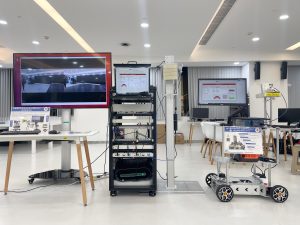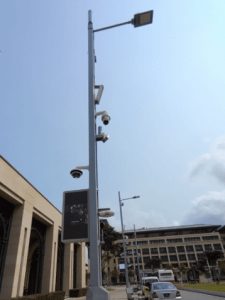The Internet of Things (IoT) has given rise to an era of interconnectivity, bridging the gap between the physical world and the virtual world. It is also the key technology in the development of smart cities around the world. The State Key Laboratory of Internet of Things for Smart City (SKL-IOTSC) of the University of Macau (UM) has tasked itself with solving important scientific and technological problems facing IoT. In particular, the laboratory’s intelligent sensing and network communication group strives to enable information perception and transmission in a smart city to realise physical-virtual world integration and lay the ground for smart technology applications.
Digital Transformation of Cities Driven by Innovative Technologies
Urban sensing and network communication, two major IoT technologies, have accelerated the pace of smart upgrading of cities around the world. The group aims to tackle core problems and provide technical support for smart city development, especially in the development of new IoT-based infrastructure with comprehensive sensing capability, ubiquitous connectivity, low latency, and high safety standards.
Ma Shaodan, assistant director of SKL-IOTSC and professor in the Department of Electrical and Computer Engineering, is an expert in the field of wireless communication. She says that IoT may be conceived as a big tree, where intelligent sensing and network communication are the roots that provide the tree with the nutrients needed for growth by receiving and transmitting the information. Urban big data and smart technology are the tree trunk which tries to understand what people need through data mining and intelligent algorithms. The flowers of the tree will eventually blossom, and the fruits are data for use in major areas of smart city development, such as smart energy, intelligent transportation, as well as urban public safety and disaster prevention. ‘This can reflect the strategic research layout of the laboratory,’ says Prof Ma.
At present, the group aims to build an effective IoT-based sensing and transmission system. Through the R&D of advanced sensing and communication technologies, the researchers hope to drive the digital transformation of cities to usher them into the era of smart interconnectivity. As the leader of the group, Prof Ma says, ‘things’ that can be connected to the network exist in every corner of a city, from buildings, streets, and bridges, to stairways, vehicles, and even underground pipes. To effectively connect various ‘things’ and achieve intelligent sensing, it is necessary to implement a far-reaching network that can cover all urban spaces.
Intelligent Sensing Comparable to the Five Senses
Focusing on intelligent sensing and network communication, the researchers conduct fundamental research to expand IoT technology and lay a solid foundation for the interconnection of all elements in an urban environment. According to Prof Ma, intelligent sensing operates like the five human senses, collecting information in the physical world, such as images, videos, temperature, road conditions, and energy consumption, in order to sense the pulse of the urban operation. At the same time, network communication technology paves the way for smooth and rapid information transmission in feedback channels to inform city control, realising interactions with the physical world and leading to smart city management and operation with minimal human intervention.
The new IoT development raises the demand for better intelligent sensing and network communication technologies. The existing challenges include massive connectivity, assessing the dynamic and complex communication environment with limited resources, the diverse sensing and communication needs, applying the technology across different industries and domains, and maintaining efficient and secure transmission. To overcome these challenges, the researchers carried out studies such as intelligent reconfigurable surface-empowered communications, integrated sensing and communication, and space-air-ground integrated network. They have made significant progress, offering solid support for new IoT-based infrastructure.
Building Efficient Massive MIMO Systems
It is difficult to achieve efficient information perception and transmission without a well-established communication network. As a new digital technology, 5G network enables big data transmission in cities, but at the same time requires enhanced speed, efficiency, and reliability of wireless communication. The researchers study communication systems based on massive antennas in order to build more efficient information transmission systems. The research focuses on the key requirements of 5G system, such as low latency, massive connectivity, high speed, and ultra-reliability. Prof Ma says that the researchers are building a better environment for network communication, and providing a new means for intelligent sensing.
The group has successfully built its own massive multiple-input multiple-output (MIMO) system. Using beamforming techniques, the system takes advantage of spatial resources to realise simultaneous connections to a massive number of users in the same space and at the same frequency. The system also uses massive antennas through beamforming to subdivide space into tiny areas and ensure that each area supports simultaneous transmission of data, thus increasing network capacity and realising low latency communications.
The group has also developed new theories and optimisation methods to overcome challenges posed by massive MIMO systems, such as high-dimension channel matrix and complex channel structure, laying the theoretical and technical foundation for 5G and the design and implementation of the next-generation mobile communication system. The research result received a third prize in the Natural Science Award category of the Macao Science and Technology Awards.
Developing an Intelligent Sensing System Suitable for Macao
In addition to a highly efficient network, the speed of information feedback to the brain of a smart city also depends on smart sensors that act as ‘nerve endings’ to quickly and accurately grasp the pulse and dynamics of the city. Moreover, the collaboration between academia and industry is crucial to building an intelligent sensing system. In recent years, leading cities around the world have used smart streetlights as the building blocks of their smart city sensing systems. Macao is no exception. UM and Companhia de Electricidade de Macau conducted a collaborative project in 2020 to investigate the implementation of a smart streetlight system in Macao.
To understand the conditions required for implementing smart streetlights in Macao, the group set up a pilot site on the UM campus to explore the development of the various modules in the smart streetlight system and the design of the control platform.
According to Prof Ma, the poles of smart streetlights can perform various functions, including intelligent lighting, pedestrian and traffic flow management, environmental monitoring, and information interaction, and are therefore the cornerstones of a comprehensive sensing network in a smart city. The group will persist in bolstering its capacity to offer technical support in wireless communication and sensing networks for Macao, thereby facilitating the city’s smart development.
Text / Kelvin U, Trainee UM Reporter Zhu Jiangge
Photo / Jack Ho, with some provided by the interviewee
English Translation / Anthony Sou
Source: UMagazine ISSUE 27
Related articles:
1. Exploration and innovation: UM State Key Laboratory of Internet of Things for Smart City
2. Driving smart applications – Urban big data and intelligent technology
3.Creating a low-carbon smart energy system with high efficiency
4. Developing safe and efficient autonomous driving technologies
5. Enhancing structural health monitoring and disaster response capabilities



